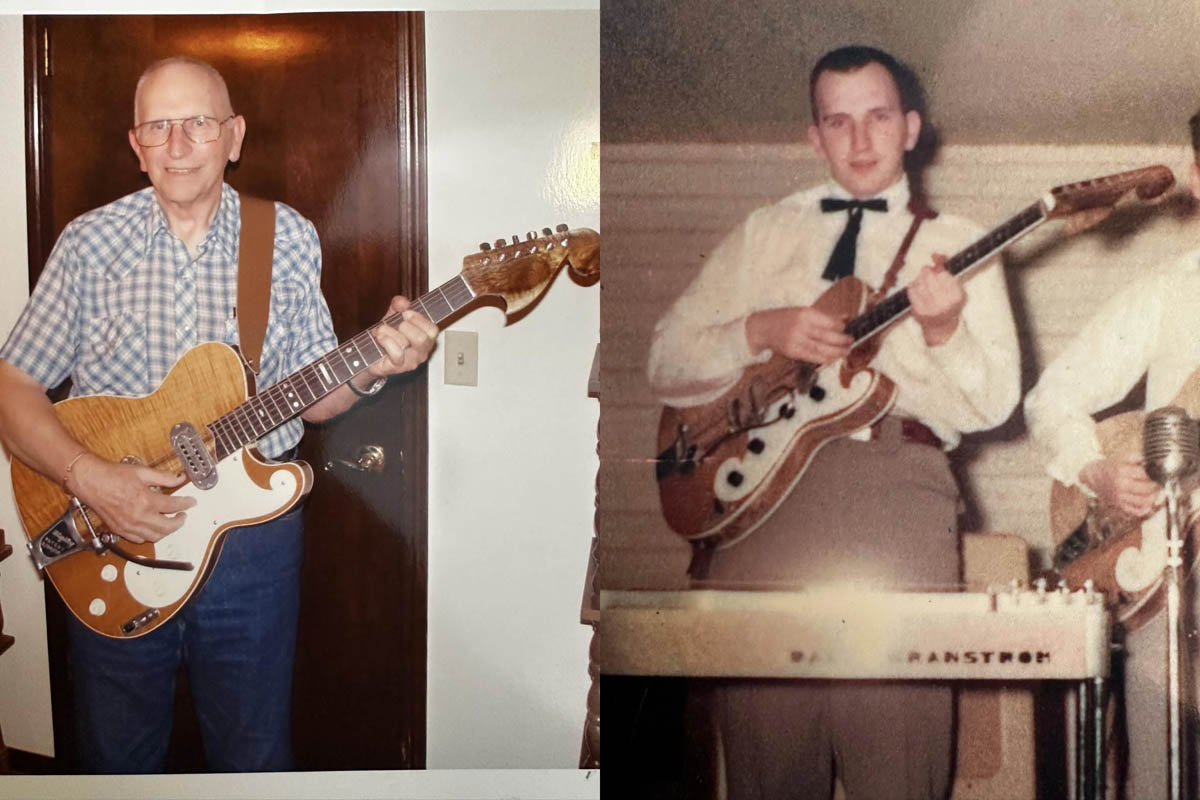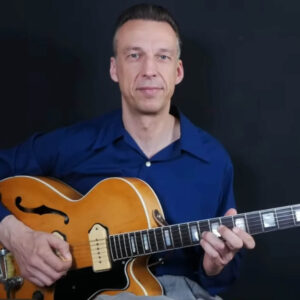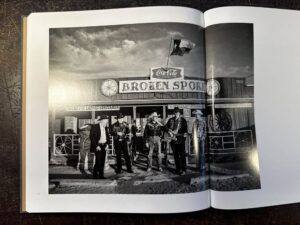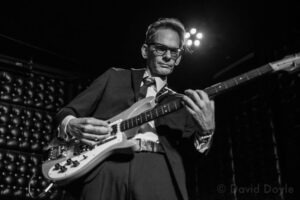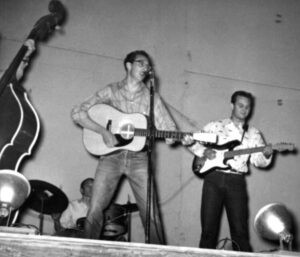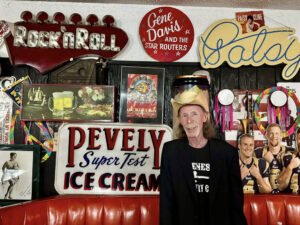I’m sad to learn that another one of my nonagenarian friends has gone to the great jam session in the sky. My buddy Dale Granstrom of Wilsonville, Oregon, passed away a couple of days ago at the age of ninety-four.
Dale was one of my favorite people. Just a supremely nice guy, always had a great positive attitude. And what a life he led! His brain was a library of information, and he was always happy to share anything that he knew.
Dale and his brother Harry grew up in Coos Bay, Oregon. They began playing in Western swing bands shortly after World War II ended, and they also both worked in a myrtlewood factory, making myrtlewood souvenirs for tourists who passed through the area. As Dale described to me, myrtlewood only grows in two places on the planet, the Holy Land in Israel and the West Coast of the United States, stretching from southern Oregon into Northern California. If you go to that area today, you will still see lots of myrtlewood souvenir stands, where you can buy the same type of highly figured plates, bowls, and other assorted items that Dale and his brother used to make seventy-five years ago.
One of the things I loved about Dale is that he always had very lofty dreams and plans, and then he figured out ways to make those ideas into a reality. As a young teenager, he saw a few bands come through the area with Bigsby instruments, and he made up his mind he was going to get a Bigsby steel guitar. At the time, these were incredibly expensive custom-built musical instruments that only top professionals could afford. But Dale saved up his money and got a Bigsby steel guitar in 1949. Dale also began a phone friendship with Paul Bigsby that would become quite important and influential.
Dale and his brother Harry came up with a plan to build some Bigsby-style instruments made out of myrtlewood. Dale consulted with Paul Bigsby, who gave him construction details over the phone. Dale revealed a lot of these details to me many years later, and in many cases, Dale revealed things about Bigsby’s construction that no one else knew (one of my favorites is that Paul Bigsby finished all of his guitars and steel guitars with Zynolyte, a uniquely hard finish used normally for refinishing hardwood floors).
Dale and his brother accumulated some of the prettiest and most highly figured pieces of myrtlewood from their factory for their guitar project. The pair worked on these two instruments during 1951. What makes the two guitars remarkable is that their designs were cosmetically a combination of the solidbody instruments Bigsby had been making for people like Merle Travis and Butterball Page; and also the new Fender solidbody instrument that debuted as the Broadcaster went through a short-lived version collectors dubbed the Nocaster, then became the Telecaster in late 1951. The fact that the Granstrom brothers opted to create an instrument that was a blend of these two highly influential and important instruments at such an early date has always blown my mind. And these brothers were not in Southern California; they were in a pretty remote place on the Oregon coast!
When Dale and Harry finished the bodies and necks for their two guitars, they shipped them to Paul Bigsby in Downey, California. Bigsby installed the fretboards, the pickups, the pickguards, the wiring harnesses, and other hardware, then sent the finished guitars back to Oregon.
Dale and his brother Harry built their first two guitars in 1951, followed by a five-string electric solidbody bass around 1954, followed by a double ten-string pedal steel guitar in 1960, all made out of myrtlewood. The only one of these known to exist today is the one that I own, the one that Dale sold to me. I have had at least four different people tell me that they saw the myrtlewood electric bass used by the Oregon state prison band in the 1960s and 1970s, but I contacted the person who runs the prison band currently, and they had no knowledge of the instrument. The other myrtlewood instruments are scattered to the wind and have never turned up.
In the late 1950s, Dale called Bigsby and asked him about the new “humbucking” pickups that were being offered by Gibson and Gretsch, and he asked if Bigsby was going to make a similar pickup. Bigsby told him that he was not going to, but that a fellow named Ray Butts in Cairo, Illinois, was making a humbucking replacement pickup for Bigsby instruments. Dale wrote to Ray Butts about the pickups, and Ray wrote him back, telling him that the pickups were available for $100 each, about the equivalent of $800 each today—big money! These pickups are super rare; less than ten of the Ray Butts Bigsby humbucking pickups are known to exist. Guitar geeks know this, but Ray Butts was the man who invented the Filter’Tron humbucking pickup for Gretsch, as well as the Echosonic amplifier used by Scotty Moore and Chet Atkins.
Dale ordered just one of the humbucking pickups (he couldn’t afford two), and installed it on his myrtlewood guitar around 1960. Dale sold the single-coil Bigsby pickup from his myrtlewood guitar to a local player in Oregon, who had a 1954 blackguard Fender Telecaster. This Telecaster with the Bigsby neck pickup floated around the Portland area for decades, seen a few times over the years. Most recently, the telecaster was sold to Joe Bonamassa, who has featured it on many of his social media posts. The Bigsby pickup on his telecaster originally came from the Dale Granstrom myrtlewood Bigsby.
Dale and his brother Harry were experienced woodworkers and machinists. The thing that really sets the myrtlewood Bigsby apart from many other “handmade“ guitars from that era is the level of craftsmanship. People who put their hands on the myrtlewood Bigsby guitar often cannot believe that it was built by a pair of young brothers in Coos Bay, Oregon. The workmanship is impeccable, and the playability rivals Bigsby’s own work.
This expert handiwork continued for Dale Granstrom. Unfortunately, his brother Harry was killed in a construction accident in 1969, but Dale kept playing music and working with his hands. When I was at his house the first time, I noticed that all of the furniture was beautifully crafted, often with light-colored blonde maplewood contrasted with dark inlays of walnut— similar to the construction of Bigsby guitars and steel guitars. I asked Dale about it, and sure enough, he had built all of the furniture in his house. It was beautiful.
Dale was also a really great pedal steel player, highly influenced by his hero, Curly Chalker. Dale continued playing in country music bands around Portland until his hands gave out a couple of years ago. He then took up the ukulele, and he kept playing in a local ukulele club until the time that he passed.
Dale and I kept in contact via email, the last time I wrote him was a few months ago. The last time I saw him in person was at a steel guitar gathering in Portland back in 2018. I had recently obtained Speedy West’s Bigsby steel guitar and had it restored by Todd Clinesmith in Oregon. After the instrument was finished, we arranged to have a party in Portland where players like Jeremy Wakefield and Russ Blake could play the instrument, and local heroes like Keith Holter (who played a Bigsby solidbody electric guitar he ordered in 1953) and Dale, of course, to be our celebrated guests.
Dale had a great time, sitting in an easy chair and taking it all in. I remember him speaking up a couple of times to correct me on a few details that I had gotten wrong about the story of the myrtlewood instruments. He was sharp as a tack up until the very end.
I know that we can’t keep these old timers around forever, but I sure am grateful for all the time that I got to spend around Dale. He was a real prince of a human being and a good friend. Russ Blake went to see him just a few weeks ago, and took the photo that I’ve included at the end of the batch of photos. I also want to thank Harley James for letting me know about Dale’s passing.
Godspeed and have a safe journey, Dale. I hope that you and your brother Harry are having a great reunion up there and picking some of those great Western swing tunes from the late 1940s. It was a pleasure, sir. Rest in peace.
See more photos at Deke’s original post.
